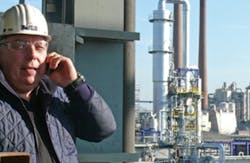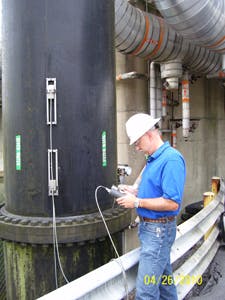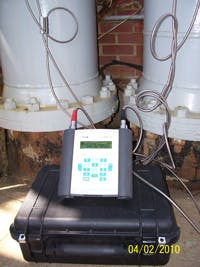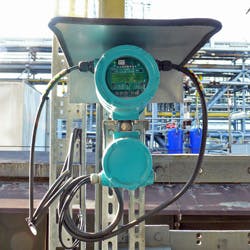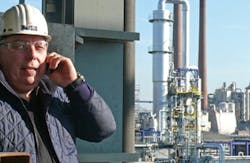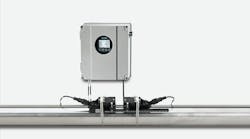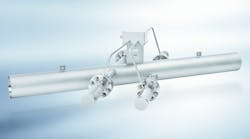Clamp-on ultrasonic flowmeters have always been an intriguing option for flow measurements where portability is required. However, early application results were uneven, leading some process companies to turn away from the clamp-on ultrasonic option. Today, new technology enhancements are earning clamp-on ultrasonic flowmeters another look.
CASE STUDY: Eastman Chemical
Greg Harper, environmental and process analysis manager at Eastman Chemical’s Kingsport, Tenn. facility, recently evaluated clamp-on ultrasonic flowmeters as a potential solution for alleviating the accuracy and consistency issues it was experiencing in some of its applications. The evaluation involved revisiting clamp-on ultrasonic meters after some prior, uneven results with the technology.
In Search of a Flow Solution
“The need for accurate, representative flow data that we could archive and access has been increasing exponentially, but there was nothing in place that could provide all the information we needed,” Harper said. “Several internal development and engineering groups had looked into clamp-on ultrasonic flowmeters with data logging capability, but nothing had been expanded to the company as a whole. Those that had the ultrasonics had varying degrees of success with older platforms of the meters, but for the most part the meters were collecting dust on a shelf.
The problem, according to Harper, was accuracy. In discussing the technology with his colleagues, Harper said he heard, “We’ve had a clamp-on ultrasonic for years, and I’ve never had much success with the thing.” And, “Clamp-on meters are very frustrating to use; you never know if they are giving you accurate readings, if you actually get any readings at all.”
Technology Revisited
Harper said he believed in the potential of clamp-on ultrasonic flowmeters, but what he was hearing required further evaluation before a decision could be made.
Harper invited representatives of all the ultrasonic meter manufacturers he could identify to come to his facility and demonstrate their meters in a variety of circumstances. Eleven accepted the challenge.
Harper identified 20 points throughout the plant. Several were in the coal gasification plant because it transports gasses and liquids and slurries of changing consistencies and temperatures. All of the selected sites had existing meters that had recently been calibrated.
“My first test for all the meters was in the parking lot where we have a 30-inch waste line,” said Harper. “Aside from accuracy, I was looking for ease of installation. After all, I have to go all over the plant measuring flow, and I don’t want to waste time setting up.” Harper said he was also looking for reliability, data logging capability, diagnostic tools, and a good battery life. “The thing with the waste line was that if it took too long to set up the meter or the accuracy wasn’t there on such an easy task, there was no point going into the other test sites,” Harper said. “Five meters didn’t make it out of the parking lot. As for the other six, some could measure liquid and not gas and vice versa. Some had trouble with slurries.”
Improved Results
In the end, Harper settled on a portable clamp-on from Flexim. “They had two distinct advantages over the others,” he said. “First, they were a combination gas/fluid meter, so I only had to buy one meter, not two. Second, their installation is a snap. The main problem with the others was installation.”
The Flexim meters have a fixed frequency on the transducers—it doesn’t matter what they are measuring, they keep that frequency. The other meters evaluated by Eastman used a sweep frequency, which may take quite a bit of time to set up and put on the pipe. Further, sweep frequency meters typically need to find a “sweet spot,” and even after this spot is found, you still have to adjust the transducers to get an accurate measurement.”
“There are many ways of getting a signal to a pipe,” said John O’Brien, general manager of Flexim Americas Corporation. “Many use multiple transducers, which operate at different frequencies to overcome the various types of pipes and wall thicknesses and types of liquids. We use the same transducer for everything, but we filter the transmission pattern and either increase the power to the transducer, or break up the pattern of transmissions to adapt to the real-world conditions.” The power to the transducer may go from 15 volts transmit to 90 volts transmit. The Flexim meters send approximately 1,000 pulses back a second in 500 pairs, and the system automatically realizes a change in the consistency of the liquid. This mode of operation can even support coal slurries, as the meters are capable of automatically realizing signal loss and increasing power to the transducers. It’s a combination of software, clever transducers, and signal processing. It can monitor anything from quarter-inch tubing to a 30-foot penstock.
“I think we can safely say that ultrasonic flowmeters have finally met their potential,” said Harper. “I have taken more than 600 readings with [the Flexim] portable meter, and my success rate is 99.8 percent; and that includes pipes containing acids, water, gasses, and slurries at several hundred degrees. At the end of the day, I collect all the data dumps from the built-in data logger and export it to my spread sheet program.”
CASE STUDY: Cognis, Specialty Chemical
Cognis, a specialty chemistry company with expertise in natural and renewable raw materials, is headquartered in Germany with facilities in more than 30 countries, including the United States. Its focus is on renewable raw materials, products, and services, which allow the processing industry and end-users to work ecologically and economically. One of its main functions involves the production of fatty alcohols that work as an important primary product for many detergents and creams. Basic materials for the production of fatty alcohols are natural products, such as coconut oil or palm oil.
A Challenging Fluid Measurement
Cognis engineers break these oils down into glycerine and fatty acid; the fatty acid is esterified and then hydrated. Hydrogen serves as a circulating gas during hydrogenation. It works both as reactant and as means of transport and is one of Cognis’s biggest monitoring challenges. In order to be able to adjust the amount of circulating gas for process control, the volume flow must be measured as accurately as possible. In addition, by measuring the circulating gas, engineers need to be able to detect if the piston compressor, which keeps the plant running, suffers any power loss caused by wear and tear.
Until recent years, these measurement challenges were handled by turbine meters. Hans-Georg Linsner is an engineer at Cognis’s fatty alcohol production plant and is responsible for electrical engineering, measuring and control technology. He describes the exceptional strain put on the turbine meters by the physical conditions. “Due to significant wear, their bearings have to be changed regularly. The meters are destroyed by liquid sloshing, which happens occasionally. The plant needed to be shut down when installing and servicing the turbine meters, and that involved considerable expense for Cognis,” said Linsner. Naturally, we were always on the lookout for an effective and efficient method to meter gas and liquid flow.”
An Ultrasonic Solution
The engineering staff at Cognis had been aware of clamp-on ultrasonic meters for some time, but the accuracy problems outweighed the benefits of being non-intrusive. Then a few years ago staff engineers became convinced the accuracy had improved enough to warrant their attention.
“For measuring the high-pressure hydrogen, the portion of sound energy transmitted into the gas is determined by the acoustic impedances of the gas and the pipe wall,” explained Bernhard Funck, Ph.D., from Flexim’s headquarters in Berlin. “The closer the respective acoustic impedances are, the more sound is transmitted from one medium to the other. The remaining sound stays in the pipe wall and acts as ambient noise there.” Since the density of gas rises with increasing pressure and its acoustic impedance converges toward that of the pipe wall, coupling of the ultrasonic signal under high pressures enables more effective flow measurement. This is why the improved non-invasive measuring method works very well under high and very high operating pressures. As a result of several innovations and improvements in all areas of signal generation, insertion and processing, the cost of non-invasive gas flow measurement has been lowered considerably, while the accuracy has improved dramatically. “Thanks to the work of our engineers, we have made huge advances in the last few years—so much so that we can even measure compressed air non-invasively.”
Since clamp-on ultrasonic meters were installed several years ago, Cognis’s process gas flow measurement has been performing reliably without any of the costly maintenance and shutdowns required by the turbine meters they replaced.
Izzy Rivera has been involved with R&D of Clamp-on Ultrasonic Flow Metering for over 30 years. He has traveled extensively as a field engineer, and has been involved with development; from the early days of inception of clamp-on metering to the vast improvements that now make it possible to measure gas from outside the pipe. His home base is at Flexim Americas Operations Center in New York. At Flexim, Mr. Rivera is responsible for managing technical service, product management & development for the Gas and HVAC markets. He can be reached at [email protected].
